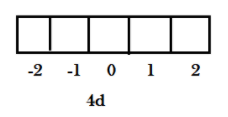
Answer
424.5k+ views
Hint: Here in $4d$ subshell number $4$ is the value of principal quantum number while d is here the azimuthal quantum number so the orbitals will be the same as an ordinary d-orbital makes. The number of orbital is the blocks that you made to represent it, like in s orbital we have to make only one block hence it will have one orbital similarly in p orbital there are three blocks made hence it will have three orbitals.
Complete step-by-step answer:
To represent any shell and its inner subshell we have four quantum numbers which by numbers sketch the naming of orbitals they contain. As we know for s orbital value $1\,s$ here $1$ is the principal quantum number the value of the main shell in which the electron exists. Now how to calculate the value for azimuthal quantum number? We can write it from $0$ to $(n - 1)$ it means we can write it in terms of a formula like,
$l\, = \,0\,\,to\,(n - 1)$ so for $1\,s$ we have $n = 1$ so if we put her the value of n we get $l = 0$ , therefore it is represented by one box or orbital having value of magnetic quantum number as ${m_l}\, = \, - l\,\,to\, + l\,$ so we get value zero. It can be represented as in figure and have two electrons of magnetic spin quantum number as $\left( { + \dfrac{1}{2}} \right)\,and\,\left( { - \dfrac{1}{2}} \right)$

Now for our question $4d$ has value of principal quantum number as $n = 4$ so if we try to calculate the value of azimuthal quantum number, it will be
$l\, = \,0\,\,to\,(n - 1)$
$l\, = \,0\,\,to\,(4 - 1)\, = \,0,1,2,3$
Among which $l = 2$ is for d orbital hence the value of magnetic quantum number is from ${m_l}\, = \, - l\,\,to\, + l\,$= ${m_l}\, = \,( - 2)\,\,to\,( + 2)$ = $ - 2,\, - 1,\,0,\, + 1,\, + 2$

Now we can say that $4d$ has five orbitals having magnetic quantum numbers from $( - 2)\,\,to\,( + 2)$ .
Note: The principal quantum number and azimuthal quantum number both give the value of all possible numbers of subshells which that principle quantum number can accommodate, we can find the subshell using the nomenclature.
$l = 0\, \to s$
$l = 1 \to p$
$l = 2\, \to d.......so\,on$
Complete step-by-step answer:
To represent any shell and its inner subshell we have four quantum numbers which by numbers sketch the naming of orbitals they contain. As we know for s orbital value $1\,s$ here $1$ is the principal quantum number the value of the main shell in which the electron exists. Now how to calculate the value for azimuthal quantum number? We can write it from $0$ to $(n - 1)$ it means we can write it in terms of a formula like,
$l\, = \,0\,\,to\,(n - 1)$ so for $1\,s$ we have $n = 1$ so if we put her the value of n we get $l = 0$ , therefore it is represented by one box or orbital having value of magnetic quantum number as ${m_l}\, = \, - l\,\,to\, + l\,$ so we get value zero. It can be represented as in figure and have two electrons of magnetic spin quantum number as $\left( { + \dfrac{1}{2}} \right)\,and\,\left( { - \dfrac{1}{2}} \right)$

Now for our question $4d$ has value of principal quantum number as $n = 4$ so if we try to calculate the value of azimuthal quantum number, it will be
$l\, = \,0\,\,to\,(n - 1)$
$l\, = \,0\,\,to\,(4 - 1)\, = \,0,1,2,3$
Among which $l = 2$ is for d orbital hence the value of magnetic quantum number is from ${m_l}\, = \, - l\,\,to\, + l\,$= ${m_l}\, = \,( - 2)\,\,to\,( + 2)$ = $ - 2,\, - 1,\,0,\, + 1,\, + 2$

Now we can say that $4d$ has five orbitals having magnetic quantum numbers from $( - 2)\,\,to\,( + 2)$ .
Note: The principal quantum number and azimuthal quantum number both give the value of all possible numbers of subshells which that principle quantum number can accommodate, we can find the subshell using the nomenclature.
$l = 0\, \to s$
$l = 1 \to p$
$l = 2\, \to d.......so\,on$
Recently Updated Pages
Who among the following was the religious guru of class 7 social science CBSE

what is the correct chronological order of the following class 10 social science CBSE

Which of the following was not the actual cause for class 10 social science CBSE

Which of the following statements is not correct A class 10 social science CBSE

Which of the following leaders was not present in the class 10 social science CBSE

Garampani Sanctuary is located at A Diphu Assam B Gangtok class 10 social science CBSE

Trending doubts
Which are the Top 10 Largest Countries of the World?

Fill the blanks with the suitable prepositions 1 The class 9 english CBSE

How do you graph the function fx 4x class 9 maths CBSE

Give 10 examples for herbs , shrubs , climbers , creepers

Change the following sentences into negative and interrogative class 10 english CBSE

Difference between Prokaryotic cell and Eukaryotic class 11 biology CBSE

The Equation xxx + 2 is Satisfied when x is Equal to Class 10 Maths

Write a letter to the principal requesting him to grant class 10 english CBSE

What organs are located on the left side of your body class 11 biology CBSE




